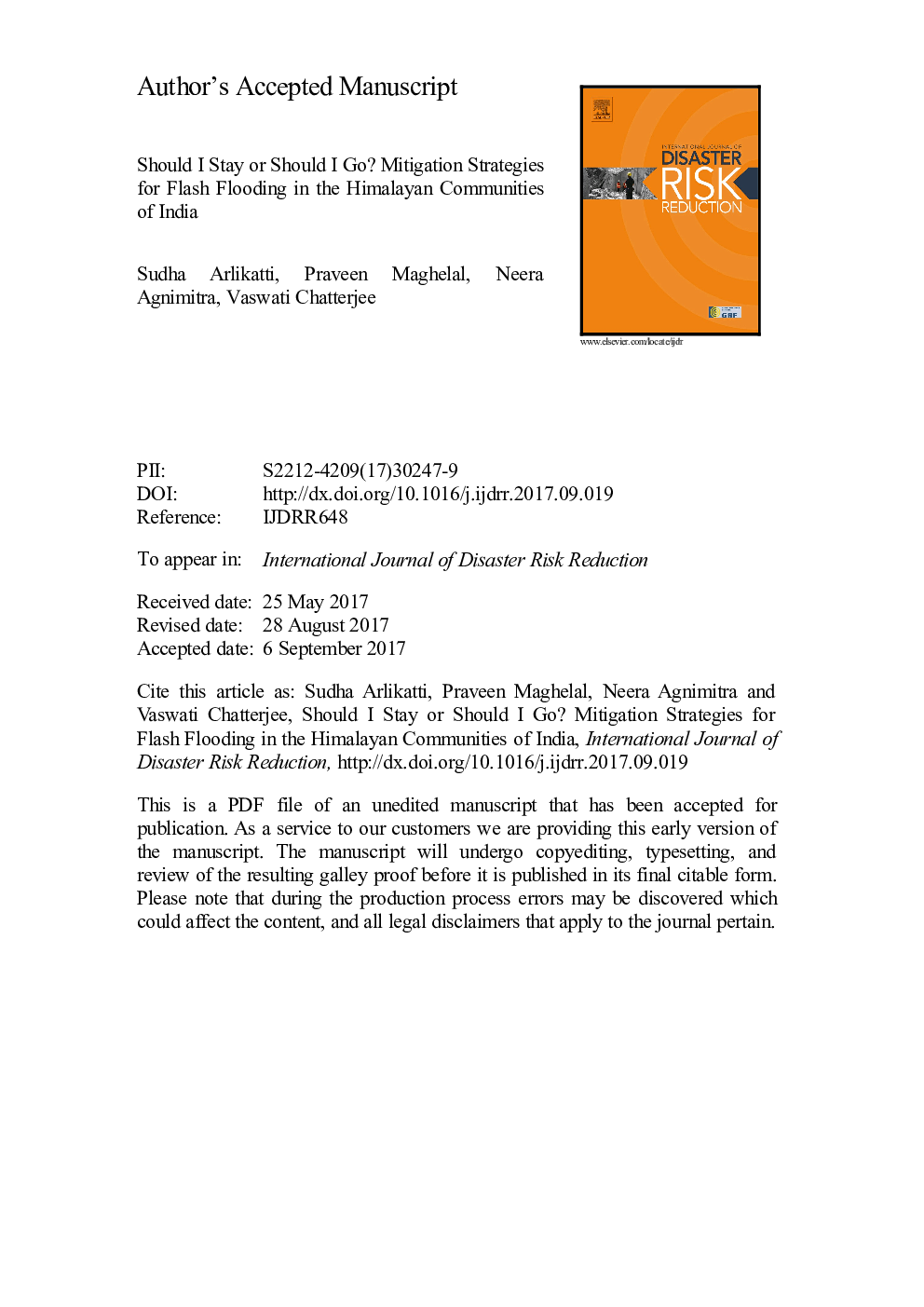| کد مقاله | کد نشریه | سال انتشار | مقاله انگلیسی | نسخه تمام متن |
|---|---|---|---|---|
| 7471884 | 1485143 | 2018 | 21 صفحه PDF | دانلود رایگان |
عنوان انگلیسی مقاله ISI
Should I stay or should I go? Mitigation strategies for flash flooding in India
ترجمه فارسی عنوان
باید بمانم یا باید بروم؟ استراتژی های کاهش تهدید برای فلاش سیل در هند
دانلود مقاله + سفارش ترجمه
دانلود مقاله ISI انگلیسی
رایگان برای ایرانیان
کلمات کلیدی
تسکین دهنده، نقل مکان پشت سر گذاشتن بهتر، فلش سیلاب اوتاراکند، هند، جوامع کوهستانی،
ترجمه چکیده
تلاش های توانبخشی و بازسازی پس از فاجعه اغلب توسط سازمان های دولتی انجام می شود و به شدت مورد نیاز است تا نیاز فوری بازماندگان فاجعه را رفع کند. با این حال در غیاب پیش از برنامه ریزی برای بازیابی فاجعه، ممکن است آسیب پذیری های اجتماعی را به دلیل شکستن روابط اجتماعی و نیازهای معیشتی افزایش دهد. به رسمیت شناختن رو به رشد است که سیاست های بالا به پایین باید با درک ترجیحات و نیازهای بازماندگان فاجعه جایگزین شود. این تحقیق به منظور سنجش استراتژی های کاهش در نظر گرفته شده است که بازماندگان منطقه هیمالیا در شمال هند پس از سوانح سقوط ناگهانی در سال 2013 بیان شده است. پرسشنامه نیمه ساختاری برای مصاحبه با 316 ساکن از 17 روستا در ایالت اوتاراکند برای اندازه گیری استفاده شد ویژگی های جمعیت شناختی، درک ریسک، تجربه خطر ابتلا به سیلاب، تجربه تخلیه، آسیب به خانه و ساختار در نظر گرفته شده (انتقال / ساختن دوباره بهتر) و غیر سازه ای (زمان سرمایه گذاری و تلاش در برنامه ریزی اورژانس یا افزایش خودآگاهی و شناخت تهدیدات دانش) اقدامات کاهش. یافته ها نشان می دهد که جابجایی یک استراتژی کاهش محبوبیت نیست. در عوض، اکثریت قاطع پاسخ دهندگان علاقه مند به برنامه ریزی اضطراری در سطح خانواده و روستا هستند. سرمایه گذاری در بازنگری و به روزرسانی طرح ها در تمام سطوح دولت، بررسی سیستم پیش بینی و هشدار موجود و ایجاد یک طرح ارتباط قوی ریسک با ورودی های محلی، به شدت اجرای مقررات قانون زلزله سالانه 2012، بهبود برنامه های آگاهی رسانی خطر و ایجاد روستا نیروهای کار گروهی با پیوند مستقیم با سازمان آژانس مدیریت بحران، برخی از توصیه های انجام شده است.
موضوعات مرتبط
مهندسی و علوم پایه
علوم زمین و سیارات
فیزیک زمین (ژئو فیزیک)
چکیده انگلیسی
Post-disaster rehabilitation and rebuilding efforts are oftentimes spearheaded by government agencies rather hastily, to meet the urgent demands of disaster survivors. However in the absence of pre-planning for disaster recovery, they may increase community vulnerabilities due to a break down in social ties and livelihood needs. There is a growing recognition that adhoc top down policies should be replaced with an understanding of the preferences and needs of disaster survivors. This research is aimed at gauging the intended mitigation strategies that survivors from the Himalayan region of North India expressed, following the devastating flash flooding in 2013. A semi-structured questionnaire was used to interview 316 residents from 17 villages in the State of Uttarakhand to measure demographic characteristics, risk perception, prior flash flood hazard experience, evacuation experience, damage to home, and intended structural (relocate/ building back better) and non-structural (investing time and effort in emergency planning or raising self-awareness and knowledge of threats knowledge) mitigation measures. Findings suggest that relocation is not a preferred mitigation strategy. Rather, an overwhelming majority of the respondents are interested in emergency planning at the household and village levels. Investing in revising and updating the plans at all levels of government, reviewing the existing forecasting and warning system and creating a robust risk communication plan with local input, strictly enforcing the provisions of Flood Plain Zoning Act, 2012, improving hazard awareness programs and creating village level task forces with direct linkages to the State Disaster Management Agency are some of the recommendations made.
ناشر
Database: Elsevier - ScienceDirect (ساینس دایرکت)
Journal: International Journal of Disaster Risk Reduction - Volume 27, March 2018, Pages 48-56
Journal: International Journal of Disaster Risk Reduction - Volume 27, March 2018, Pages 48-56
نویسندگان
Sudha Arlikatti, Praveen Maghelal, Neera Agnimitra, Vaswati Chatterjee,
